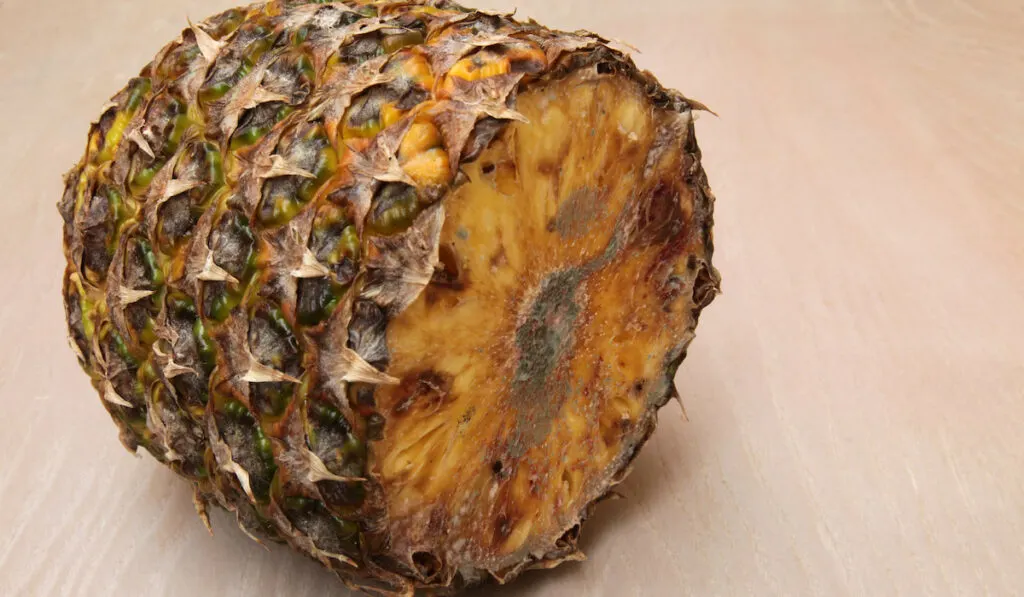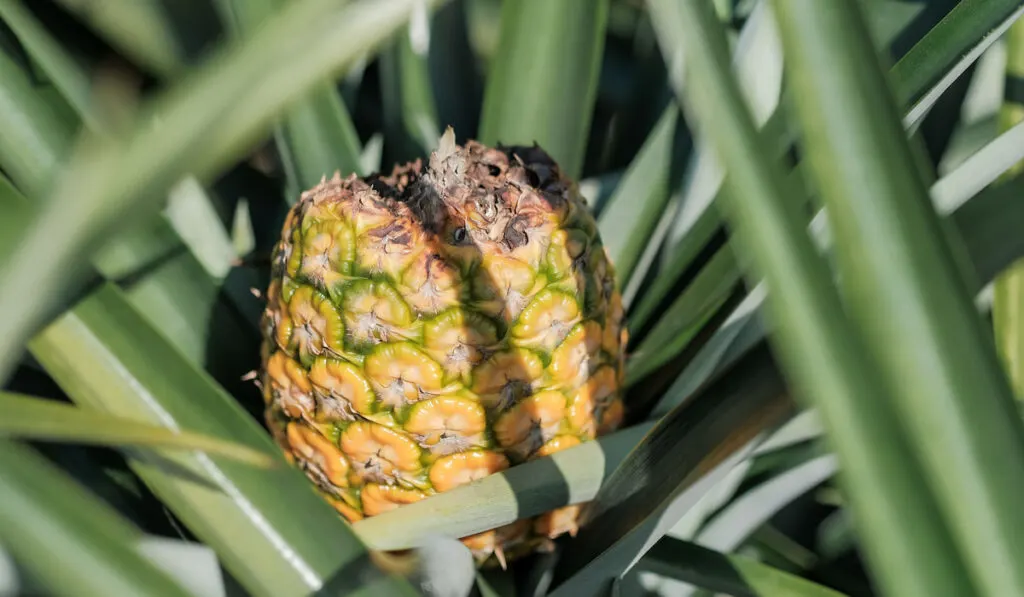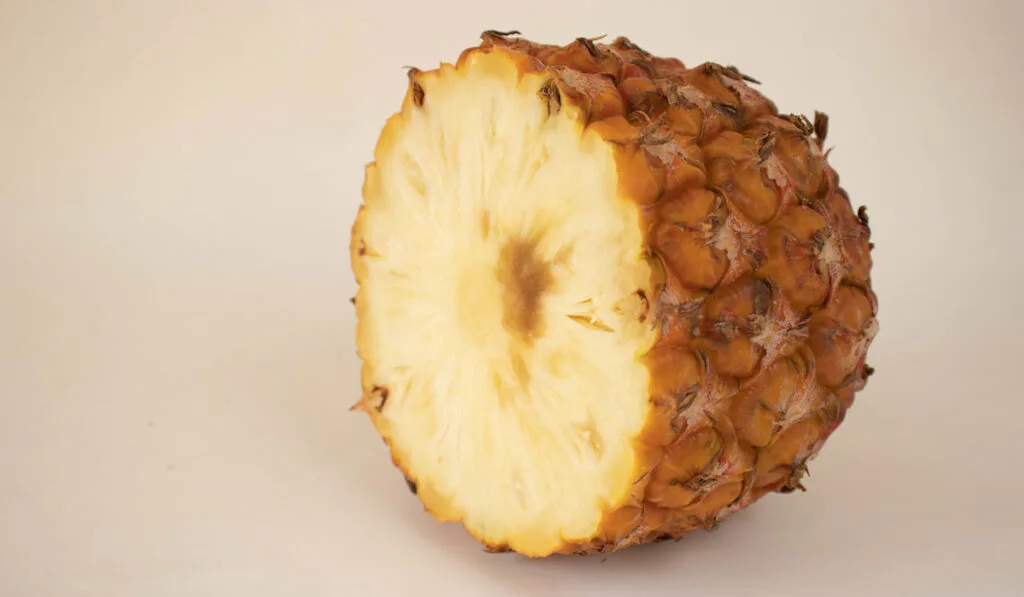Have you ever noticed those annoying red spots when you cut a pineapple? I know I have, and it can be frustrating. And who wants to eat an unappealing fruit?
The sweet juicy flesh is one of the best things about ripe pineapples, but now and then, you’ll run into some red spots.
Eating pineapple with red spots may pose a risk of health issues like food poisoning, so it is not just the fruit’s appearance that is problematic.
Most of us who have ever come across red spots in pineapples are often baffled with the question “Is the presence of red spots indicative of a disease, insects, or anything else?”
The presence of red spots in your pineapple might make you feel uncomfortable eating it.
To ease your concerns and dispel any lingering uncertainties, we’ve included three reasons why pineapples get red spots and if they’re safe to consume.

Table of Contents
1. Red Spots Can Be Caused by the Marbling Disease
Red patches on pineapples may signify marbling disease.
Some scientists disagree on the type of bacterium that causes this disease. Some claim that the bacterium Erwinia herbicola causes marbling, while others assert that Pantoea ananatis and Acetobacter spp are to blame.
Still, marbling is a bacterial disease that affects the fruit’s flesh, causing red and brown discoloration.
The bacteria can enter the fruit through wounds or natural openings and spread throughout the flesh, causing the fruit to rot. It generally starts as small, dark spots that spread and become more pronounced as the disease progresses.
Prevention and Treatment of Marbling
The only way to prevent marbling is if you are the farmer growing the fruit.
If you happen to be growing the pineapples yourself, then it is advisable to monitor your pineapples regularly for signs of marbling and remove any infected plants and debris.
Also, avoid overcrowding of plants and ensure proper spacing and air circulation

2. Red Spots Can Be Caused by Sunscald
Sunscald can occur when you overexpose pineapples to direct sunlight, causing red spots.
So, when you’re in the grocery store or market looking for a pineapple, look for the following sunscald symptoms:
- The skin has crimson patches.
- The affected area is swollen and leathery.
- The fruit is decaying.
- The fruit is overripe.
However, sunscald occurs not only when fruits are on the farm or before buying them. You can still buy a freshly ripe pineapple, and the way you store it in your home may lead to sunscald.
To avoid sunscald, follow these steps to store your pineapple and keep it fresh:
- Always place the pineapple in a cool, dark, and well-ventilated place.
- Always cover the pineapple in light-colored and breathable cloth to allow air circulation if you do not have a cool, dark-ventilated place to store them. This decreases exposure to light, which might cause discoloration or sunscald.
- Always ensure that you have stored the pineapple away from ethylene-producing fruits. Ethylene is a ripening hormone generated by some fruits that causes surrounding fruits to ripen and perish faster. To avoid this, keep your pineapple away from other fruits that produce ethylene, such as apples, bananas, and tomatoes.

3. Red Spots Can Be Caused by Insect Damage
When insects puncture the pineapple’s skin to extract its juices, they create entry holes. Such entry holes created by insects enable bacteria or fungi to infect the fruit, resulting in red spots or rotting.
The appearance of red or brown stains on the fruit’s surface mark the entry points. You can also check for sticky secretions and the presence of insects or their chaff to confirm if insects have damaged your pineapple.
However, insect damage to fruit can vary based on the type of pest present and the level of infestation. Among the possible damages are:
- Reduced quality: Insect damage can result in discoloration, fruit looking bad, and a quick decline in the overall appearance of the fruit.
- Reduced storage life: Insect damage can increase the risk of secondary infections by bacteria or fungi, which can cause the fruit to rot.
- Reduced nutritional value: Insect damage can result in the loss of vital nutrients and juices, reducing the nutritional value of the fruit. As a result, consuming insect-infested pineapple may do more harm than good to your body.
Is It Safe to Eat a Pineapple With Red Spots Inside?
While removing the red spots on a pineapple may be tempting, doing so does not guarantee that the rest of the fruit is safe to eat. A pineapple with red spots may be unsafe to eat for various reasons.
For starters, the red spots may also suggest that the pineapple has become overripe and is no longer fresh, resulting in a less desirable flavor and texture.
Bacteria can then spread rapidly on overripe fruit, causing it to degrade and become unsafe to eat.
Also, if there is discoloration, a strong odor, or a mushy texture, infected areas may cause food poisoning.
Because overripe pineapples break down and host harmful germs, they increase the risk of food poisoning.
Finally, like with any fruit, if you are unsure if it is safe to consume, be cautious and discard it.

Does the Color of a Pineapple Matter for It to Be Safe to Eat?
The color of the pineapple does not signify it is safe to eat. What it does, however, is show the different stages of pineapple ripening.
For instance, pineapples can have different colors depending on their ripeness and growing conditions. Some of the common colors that a pineapple can have are shown in the table below:
| Color | What it means |
| Green | How an unripe pineapple looks. |
| Yellow | Pineapples transform from green to yellow as they ripen. The yellow hue may begin at the bottom and progress upward. |
| Orange | When a pineapple is fully ripe, some might become orange. This reveals how sweet and juicy the pineapple is. |
| Brown | Overripe pineapples may begin to change color and form soft brown areas, which will cause them to rot more quickly. |
Despite the red dots, your pineapple can be any of these colors and still be unsafe to consume.
If you insist on eating your pineapple, perhaps because the red spots are few, here are a few ways to assess if it is safe:
- Assess the general condition. Fresh pineapple should be firm to the touch. The presence of red spots or evidence of decomposition indicates that the fruit has passed its prime.
- Perform a scent test. A ripe pineapple should have a sweet aroma; if it smells sour or odd, it could be unsafe to eat. A sour or off-odor may signal spoiling or bacterial growth, both of which can lead to foodborne illness. It’s always wise to be cautious and avoid eating any fruit that doesn’t smell fresh and pleasant.
- Do a taste test. By cutting off a little piece of the fruit and tasting it, you should be able to tell if it’s sweet and juicy or has a sour flavor.
Still, keep in mind that these methods do not always ensure the safety of the fruit; therefore, we recommend you exercise caution.
When purchasing pineapple, don’t just look at the color; feel the fruit to see whether it’s firm and look for signs of spoiling or mushy texture.

Conclusion
Red spots on pineapples occur because of bacteria causing marbling, overexposed to direct sunlight, and insect damage.
However, you can avoid all these by ensuring you buy firm pineapples with a green or fresh yellow appearance. Then, to reduce the risk of spoilage, store the pineapples in a cool, dry place far from other fruits and the sun.
By following these guidelines, you can enjoy the sweet, juicy flavor of a ripe, fresh pineapple.
Resources:
- https://ask2.extension.org/kb/faq.php?id=259383
- https://www.reddit.com/r/Whatisthis/comments/js94a0/what_is_this_red_thing_inside_a_freshly_cut/
- https://www.celebritiesbuzz.com.gh/why-does-my-pineapple-have-a-red-spot/
- https://topcookingstories.com/library/lecture/read/183628-why-is-there-a-red-spot-in-my-pineapple#0
- https://plantvillage.psu.edu/topics/pineapple/infos
- https://www.chineseherbshealing.com/pineapple-fruit/pinkdisease-fruitcollapse-and-marblingdisease-bacteria.html
